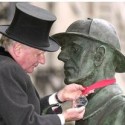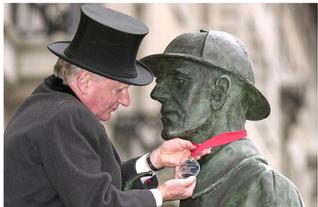A Scion Society of The Baker Street Irregulars

Science Group Honors Sherlock Holmes (2002)
“… I should have had a medal the size of a soup plate.”
– The Adventure of The Three Garridebs (3GAR)

LONDON (AP) October 16, 2002 – It may seem elementary now, but when Sherlock Holmes used his knowledge of chemistry to crack cases, he broke important ground in crime detection.
On Wednesday, the Royal Society of Chemistry recognized the contribution to forensic science made by Sir Arthur Conan Doyle’s famous detective with a coveted honorary fellowship _ the first time a fictional character has been honored.
“Sherlock Holmes was way beyond his time in using chemistry and chemical sciences as a means of cracking crime,” said John Watson, a fellow of the Royal Society of Chemistry and namesake of Holmes’ doctor friend.
“Many years ago Holmes was using what would one day be forensic science in detection. Thanks to this science today, more crimes are solved than ever before,” Watson said in bestowing the honor at a ceremony at the statue of the sleuth outside Baker Street subway station in London.
The honor marks the centenary of Holmes’ most celebrated case, “The Hound of the Baskervilles,” as well as the 100th anniversary of Conan Doyle’s knighthood.
Since Holmes and Watson first emerged from their smog-shrouded Baker Street lodgings to take on the most baffling cases known to Victorian England, chemistry has become an important part of the fight against crime.
The chief executive of the Royal Society of Chemistry, David Giachardi, said Holmes has helped ignite the process, with Conan Doyle anticipating the modern use of chemistry in crime detection by about 120 years.
“The value of the Holmes legend today, and in previous decades, is profound, having brought tangible moral benefits to society as well as providing extraordinary entertainment value,” Giachardi said.
“Our particular interest is his love of chemistry, and the way that he wielded such knowledge for the public good, employing it dispassionately and analytically. He also embodied other personal traits that society seeks in today’s law officers _ personal rectitude and courage.”
Among other things, Holmes used science to interpret the meaning behind a heap of mysterious tobacco ashes to date documents and read footprints.
Conan Doyle graduated as a doctor at Edinburgh University but later turned to writing: in all, Holmes and Dr. Watson were featured in four novels and 56 short stories.
“Holmes did not exist but he should have existed. That is how important he is to our culture,” said Giachardi. “We contend that the Sherlock Holmes myth is now so deeply rooted in the national psyche through books, radio and television that he has transcended fictional boundaries.”
This story was originally distributed by the Associated Press on October 16, 2002.

Did I tell you that when Dr John Watson official presented the FRCS medal to (the statue of) Sherlock Holmes, he was wearing my top hat and overcoat?